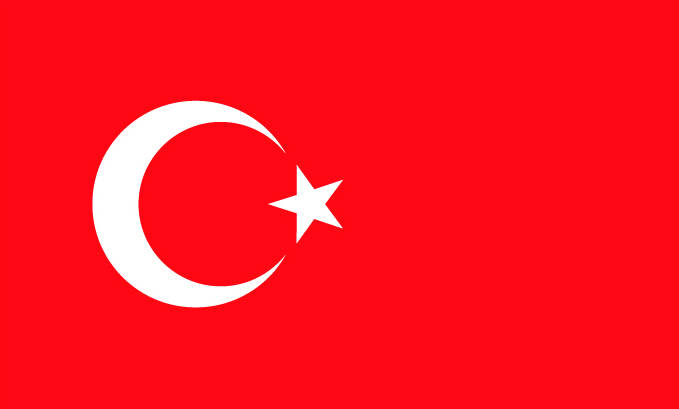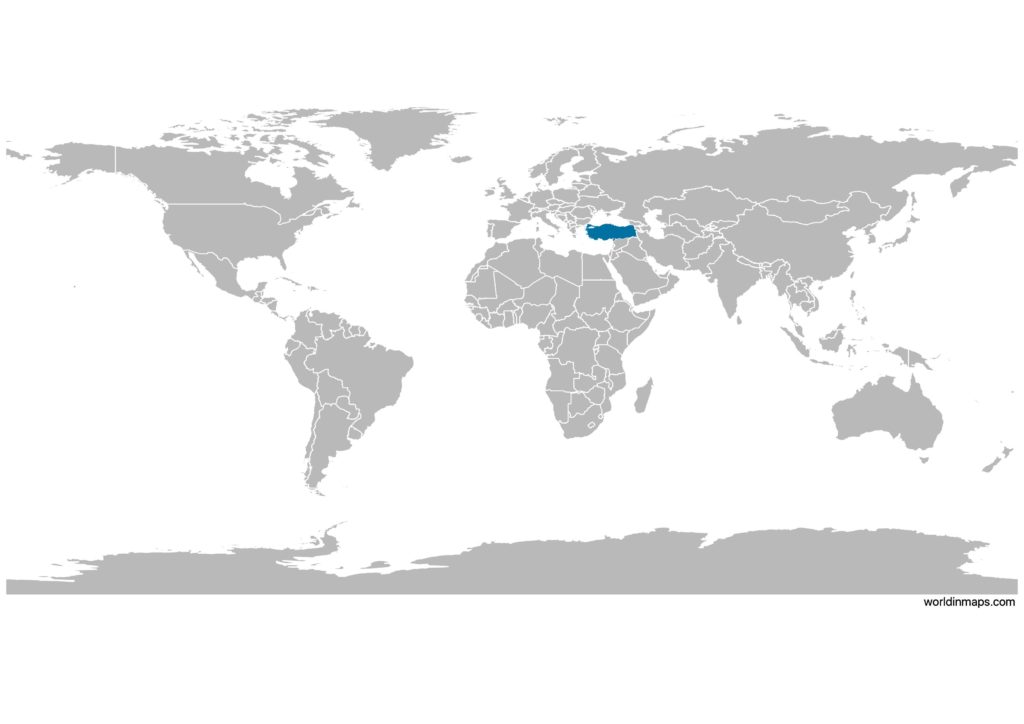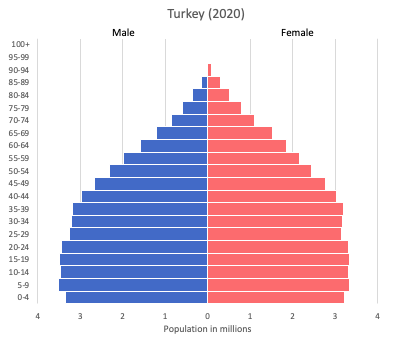Turkey

| Government | |
| Name | Republic of Turkey |
| Turkish | Türkiye Cumhuriyeti |
| Government type | presidential republic |
| Capital | Ankara (5,639,076 (2019)) |
| Currency | Turkish lira (TRY) |
| People | |
| Population (2020) | 84,339,067 (18th) |
| Density of population | 105 P/km2 (107th) |
| Nationality | Turkish |
| Official languages | |
| Turkish | |
| Ethnic groups (2016) | |
| Turkish | 70-75% |
| Kurdish | 19% |
| other | 7-12% |
| Religions | |
| Muslim (mostly Sunni) | 99.8% |
| other (mostly Christians and Jews) | 0.2% |
| Life expectancy (2020) | |
| Male | 73.3 years |
| Female | 78.2 years |
| Total population | 75.7 years (110th) |
| Homicides | |
| Total (2018) | 2.6 per 100,000 people (86th) |
| Geography | |
| Land area | 769,632 km2 |
| water area | 13,930 km2 |
| total area | 783,562 km2 (38th) |
| Mean elevation | 1,132 m |
| Lowest point | |
| Mediterranean Sea | 0 m |
| Highest point | |
| Mount Ararat | 5,137 m |
| Land use (2011) | |
| Agricultural land | 49.7% |
| Arable land | 26.7% |
| Permanent crops | 4% |
| Permanent pasture | 19% |
| Forest | 14.9% |
| Other | 35.4% |
| Urbanization | |
| Urban population (2020) | 76.1% |
| Rate of urbanization | 2.04% annual rate of change (2015 – 2020) |
| Economy | |
| Labor force (2017) | 31.3 million (19th) |
| Labor force by occupation (2016) | |
| Agriculture | 18.4% |
| Industry | 26.6% |
| Services | 54.9% |
| Unemployment rate (2017) | 10.9% (147th) |
| GDP (PPP) (estimate 2020) | |
| Total | $2.464 trillion (13th) |
| Per capita | $29,326 (52nd) |
| GDP (nominal) (estimate 2020) | |
| Total | $813.810 billion (19th) |
| Per capita | $9,683 (70th) |
| GDP by sector (estimate 2017) | |
| Agriculture | 6.8% |
| Industry | 32.3% |
| Services | 60.7% |
| Exports (2017) | $166.2 billion (30th) |
| Exports partners (2017) | |
| Germany | 9.6% |
| UK | 6.1% |
| UAE | 5.9% |
| Iraq | 5.8% |
| US | 5.5% |
| Italy | 5.4% |
| France | 4.2% |
| Spain | 4% |
| Imports (2017) | $225.1 billion (22nd) |
| Imports partners (2017) | |
| China | 10% |
| Germany | 9.1% |
| Russia | 8.4% |
| US | 5.1% |
| Italy | 4.8% |
Turkey on the world map

Turkey is located in the western part on the European continent and in the eastern part on the Asian continent. A part of Turkey is considered to be in the region of the Middle East.
Turkey top 10 largest cities (2019)
- Istanbul (15,519,267)
- Ankara (5,639,076)
- İzmir (4,367,251)
- Bursa (3,056,120)
- Antalya (2,511,700)
- Adana (2,237,940)
- Konya (2,232,374)
- Şanlıurfa (Urfa) (2,073,614)
- Gaziantep (2,069,364)
- Mersin (1,840,425)
Demography
Population pyramid

Age structure data
Estimate for 2020:
- 0-14 years: 23.41% (male 9,823,553/female 9,378,767)
- 15-24 years: 15.67% (male 6,564,263/female 6,286,615)
- 25-54 years: 43.31% (male 17,987,103/female 17,536,957)
- 55-64 years: 9.25% (male 3,764,878/female 3,822,946)
- 65 years and over: 8.35% (male 3,070,258/female 3,782,174)
Remark: the age structure of a population affects a nation’s key socioeconomic issues. Countries with young populations (high percentage under age 15) need to invest more in schools, while countries with older populations (high percentage ages 65 and over) need to invest more in the health sector. The age structure can also be used to help predict potential political issues. For example, the rapid growth of a young adult population unable to find employment can lead to unrest.
Population from 1950 to 2020
Source: United Nations, Department of Economic and Social Affairs, Population Division (2019). World Population Prospects 2019, Online Edition. Rev. 1.
Evolution of the life expectancy from 1960 to 2018
Source: World Development Indicators, The World Bank
Economy
Agriculture:
tobacco, cotton, grain, olives, sugar beets, hazelnuts, pulses, citrus; livestock
Industries:
textiles, food processing, automobiles, electronics, mining (coal, chromate, copper, boron), steel, petroleum, construction, lumber, paper
Exports – commodities:
apparel, foodstuffs, textiles, metal manufactures, transport equipment
Imports – commodities:
machinery, chemicals, semi-finished goods, fuels, transport equipment
Time zone and current time in Turkey
Go to our interactive map to get the current time in Turkey